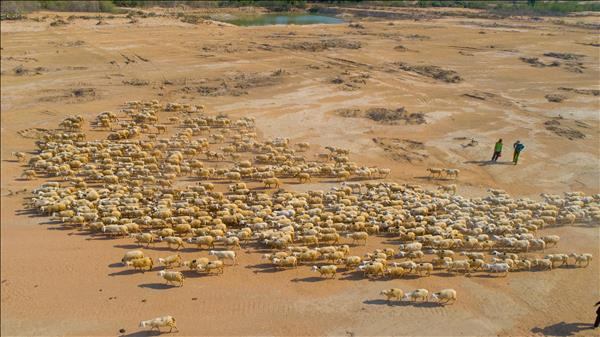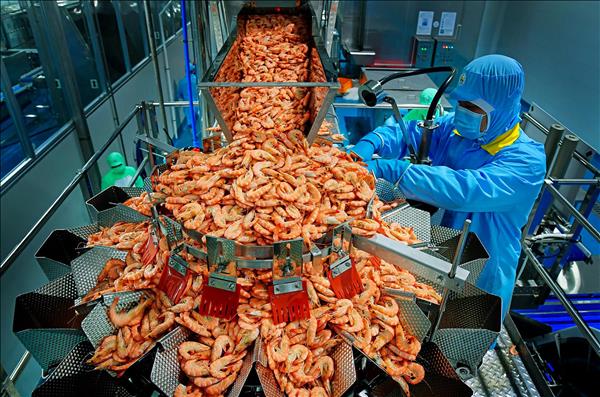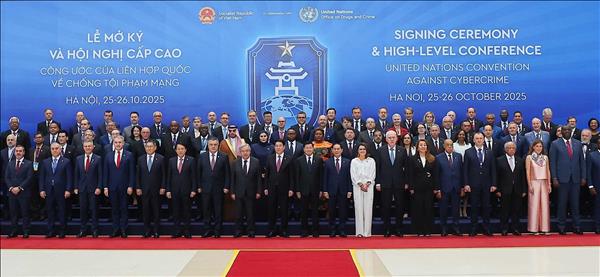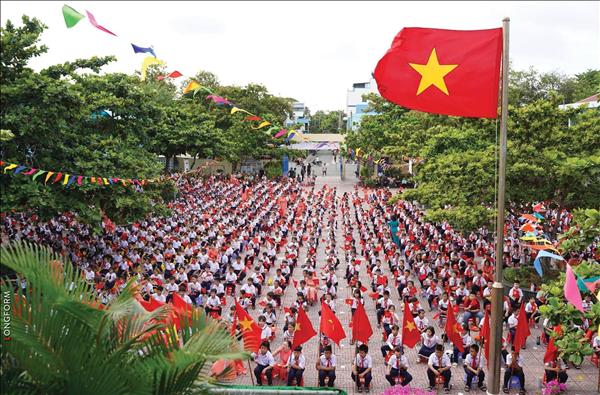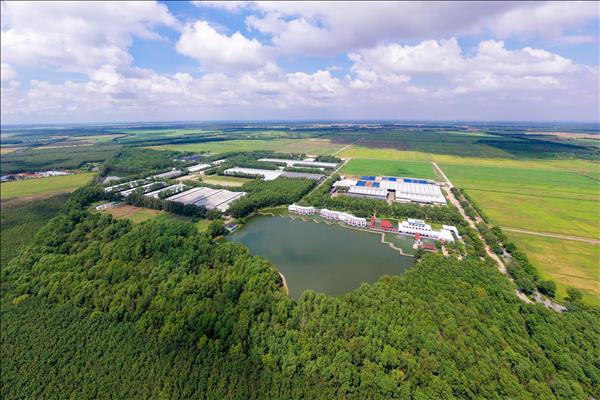The event was chaired by Japanese Prime Minister Shinzo Abe and was attended by Vietnamese PM Nguyen Xuan Phuc, Cambodian PM Hun Sen, Lao PM Thongloun Sisoulith, Thai PM Prayut Chan-o-cha and Myanmar State Counsellor Aung San Suu Kyi.
The leaders reviewed cooperation over the past years, discussed major orientations for cooperation in the time ahead, and exchanged views on some international and regional issues.
They shared the view that 10 years since its foundation, Mekong-Japan cooperation has recorded many achievements in line with the set directions which are building a Mekong region of long-term peace and stability; developing economy and actively contributing to ASEAN integration.
Regarding the New Tokyo Strategy 2015 for 2016-2018, the leaders welcomed the implementation of hundreds of projects in multiple areas, helping improve infrastructure connectivity and promote economic-industrial cohesion and people-to-people exchange between Japan and the Mekong region.
The Mekong leaders appreciated Japan’s provision of over 750 billion JPY in assistance for 2016-2018.
Agreeing to lift Mekong-Japan cooperation to a strategic partnership, the two sides said cooperation in the time ahead will focus on three main pillars, namely vibrant and effective connectivity, people-centered society, and cooperation in health care, education and justice.
The summit agreed to organize Mekong-Japan Exchange Year 2019 to enhance understanding and exchange among people of the Mekong countries and Japan. They also agreed to realize a “green Mekong”, focusing on fostering collaboration with international and regional organizations, especially the Mekong River Commission, in managing and sustainably using Mekong water resources. The countries will work together to cope with climate change; reduce, treat and recycle waste; and preserve and sustainably use fisheries resources.
At the end of the meeting, the leaders adopted the Tokyo Strategy 2018 for Mekong-Japan Cooperation in the 2019-2021 period.
The role of Vietnam in Mekong – Japan cooperation
In his article published on the English-language Japan Times on October 6, Professor Ryo Ikebe from Senshu University pointed to the unique geographic location of the Mekong sub-region which was linked to major markets and dynamic economies in Asia such as India, China and ASEAN. With such advantages, the Mekong subregion has the potential to become a center of production, consumption of ASEAN and an important link in the global value chain.
Japan has promoted a cooperation mechanism with the Mekong subregion since 2007, with the Mekong region as a key component of its aim to establish an “arc of freedom and prosperity”.
Regarding the role of Vietnam in the Mekong-Japan cooperation, Professor Ikebe underlined that Vietnam, located at the gateway, downriver point of the Mekong river, has positively participated in many cooperation mechanisms of the Mekong sub-region, especially the Mekong-Japan cooperation mechanism.
Vietnam has participated in trade and investment facilitation activities under the Greater Mekong Subregion with the simplification of customs and visa procedures for traders in the region. For example, the country has actively negotiated and finalized regulations and procedures in data sharing, water use monitoring, flow maintenance and water conservation in the Mekong river.
The country has also actively participated in “A Decade Toward the Green Mekong” Initiative in the Japan-Mekong cooperation.
Within the framework of the Mekong-Japan cooperation, Japan has for years been the biggest ODA provider for Vietnam. Many projects from this source have contributed to the socio-economic development of Vietnam, becoming symbols of the Vietnam-Japan frienship. Some of these include the Nhat Tan bridge, Noi Bai international airport and Can Tho bridge. These infrastructure projects also contribute to connecting the Mekong river delta and implement high quality infrastructure export strategy of Japan.
Mekong-Japan cooperation has strengthened the comprehensive Japan – Vietnam relationship in many fields. In 2017, Japan became the largest foreign investor to Vietnam, with a total foreign direct investment (FDI) capital of 9.1 billion US dollars, and has maintained its first position in first six months of this year with FDI capital of 6.5 billion US dollars.
The number of Japanese enterprises operating in Vietnam is now around 3,100, up 40% over the last four years. The number of Japanese enterprises that are members of the Japan Business Association in Vietnam had by June 2018 reached 1,788, the largest number of all among Japanese business associations in Southeast Asian countries.
Two way trade reached 33.84 billion US dollars in 2017 and 8.7 billion US dollars in the first quarter of 2018. Japan is the fourth largest trader of Vietnam and the largest one among member states of the Comprehensive and Progressive Agreement for Trans-Pacific Partnership (CPTPP).
The leaders reviewed cooperation over the past years, discussed major orientations for cooperation in the time ahead, and exchanged views on some international and regional issues.
They shared the view that 10 years since its foundation, Mekong-Japan cooperation has recorded many achievements in line with the set directions which are building a Mekong region of long-term peace and stability; developing economy and actively contributing to ASEAN integration.
Regarding the New Tokyo Strategy 2015 for 2016-2018, the leaders welcomed the implementation of hundreds of projects in multiple areas, helping improve infrastructure connectivity and promote economic-industrial cohesion and people-to-people exchange between Japan and the Mekong region.
The Mekong leaders appreciated Japan’s provision of over 750 billion JPY in assistance for 2016-2018.
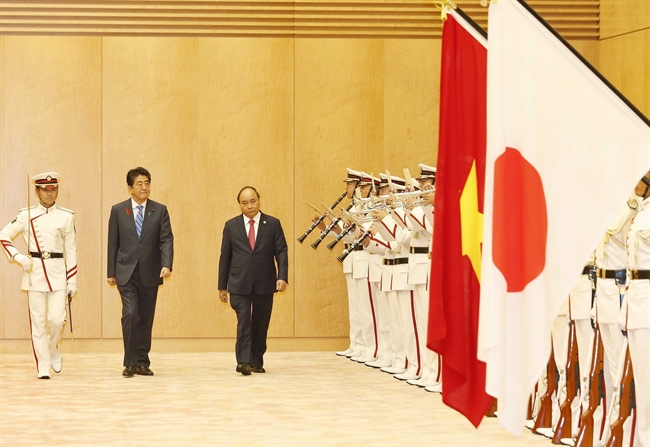 Prime Minister Nguyen Xuan Phuc and his Japanese counterpart Shinzo Abe review the honor guard at a ceremony to welcome the Vietnamese Prime Minister. Photo: Thong Nhat/VNA 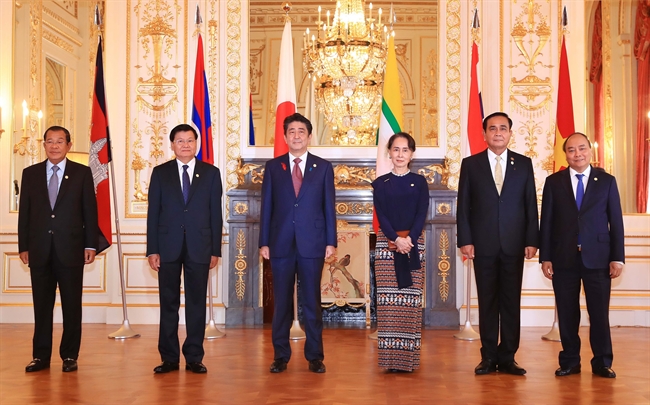 From right, Prime Minister Nguyen Xuan Phuc, Thai PM Prayut Chan-o-cha, Myanmar State Counsellor Aung San Suu Kyi, Japanese PM Shinzo Abe, Lao PM Thongloun Sisoulith and Cambodian PM Hun Sen at the summit. Photo: Thong Nhat/VNA 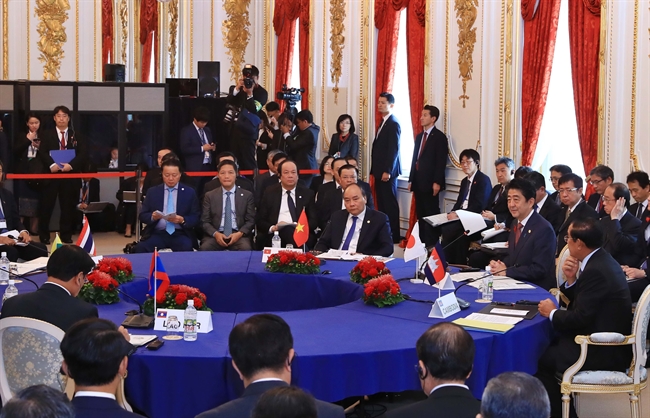 Prime Minister Nguyen Xuan Phuc and the Vietnamese delegation at the 10th Mekong -Japan Summit. Photo: Thong Nhat/VNA 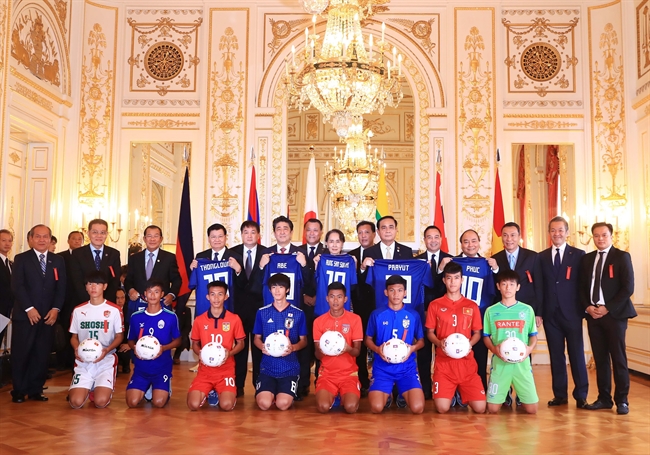 Heads of delegations and delegates to the summit pose for a photo with captains of football teams competing at the Japan-Mekong U-17 Football Tournament. Photo: Thong Nhat/VNA 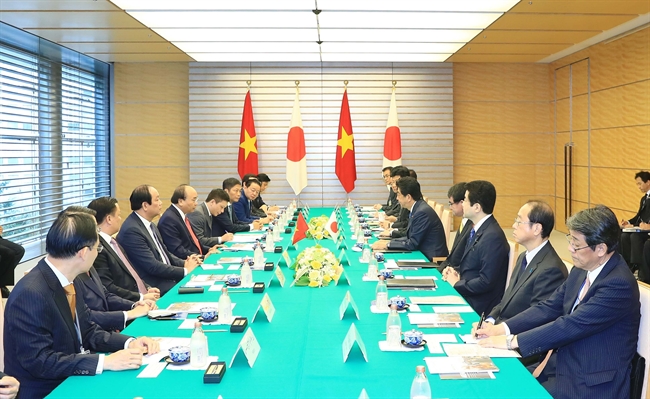 Prime Minister Shizo Abe holds talks with his Vietnamese counterpart Nguyen Xuan Phuc. Photo: Thong Nhat/VNA 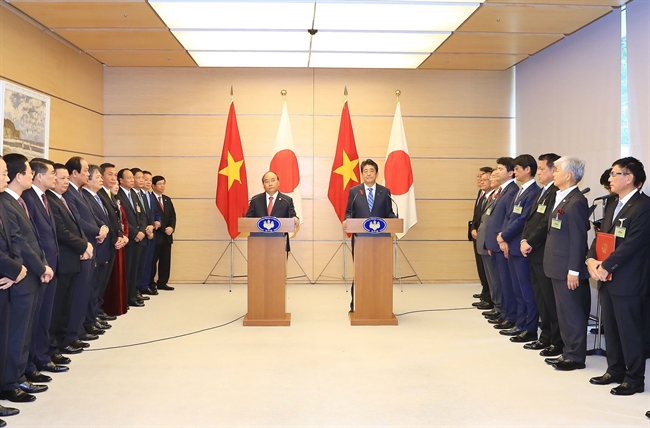 The two Prime Ministers hold a press conference after their talks. Photo: Thong Nhat/VNA 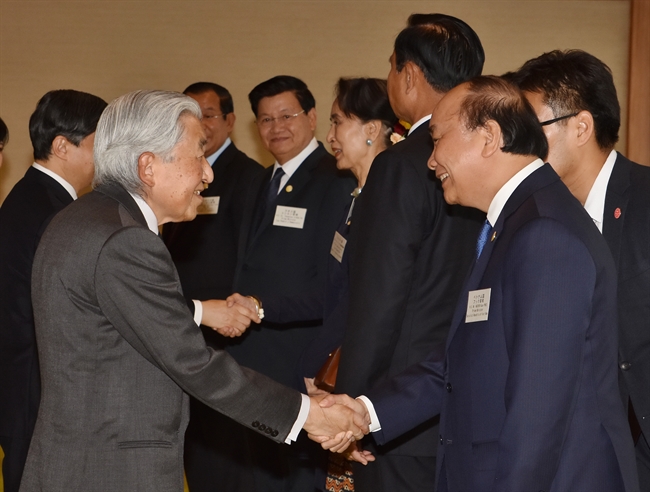 Prime Minister Phuc and heads of delegations attending the 10th Mekong – Japan Summit had a meeting with Japanese Emperor Akihito in Tokyo on October 9. Photo: VNA 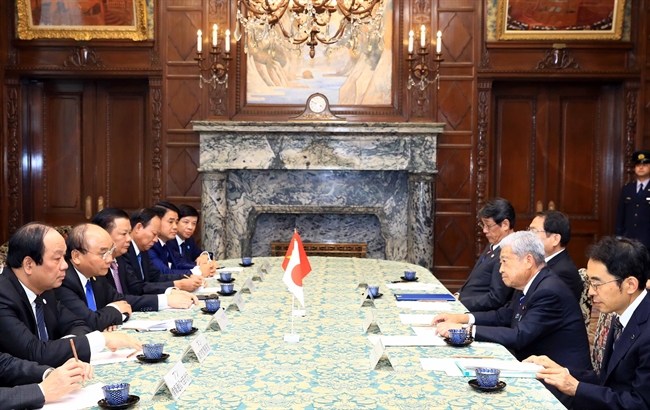 The Vietnamese leader has a meeting with Japanese Speaker of the House of Councilors Chuichi Date. Photo: Thong Nhat/VNA 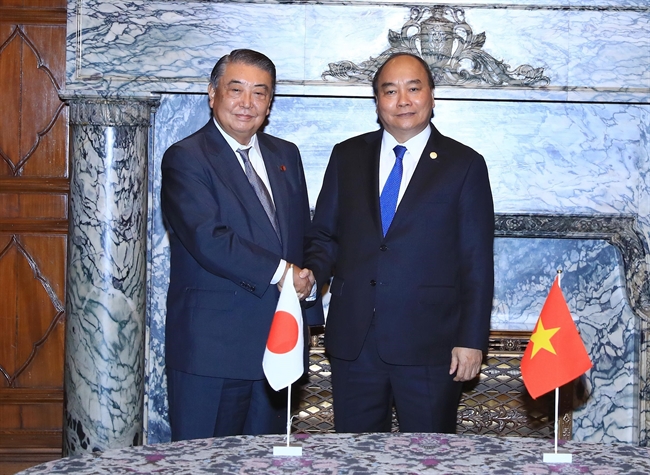 He also meets with Speaker of the House of Representatives of Japan Tadamori Oshima. Photo: Thong Nhat/VNA 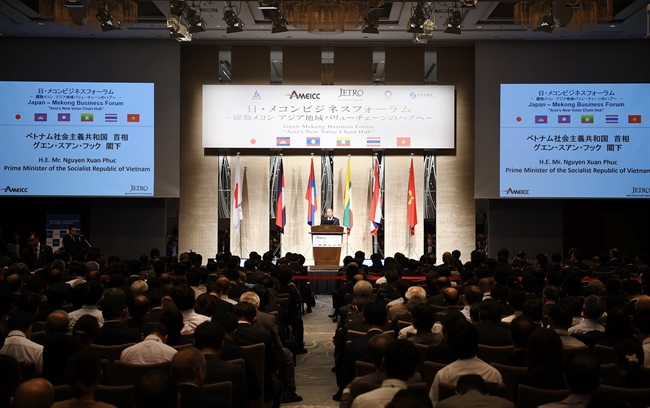 Prime Minister Nguyen Xuan Phuc addresses the Mekong-Japan Business Forum hosted by JETRO. Photo: Thong Nhat/VNA 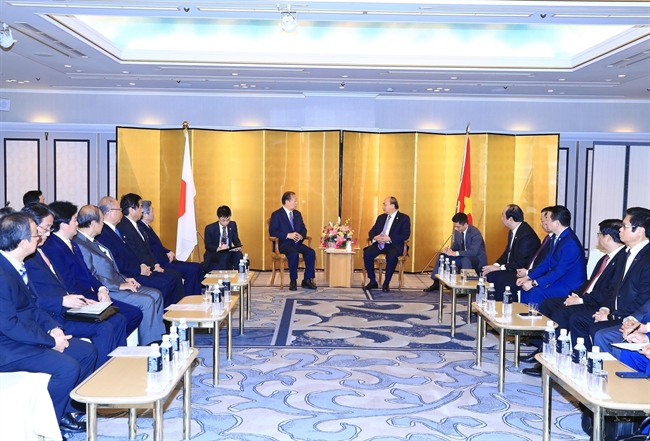 He has a reception for Chairman of the Japan-Vietnam Friendship Parliamentary Alliance Toshihiro Nikai. Photo: Thong Nhat/VNA |
The summit agreed to organize Mekong-Japan Exchange Year 2019 to enhance understanding and exchange among people of the Mekong countries and Japan. They also agreed to realize a “green Mekong”, focusing on fostering collaboration with international and regional organizations, especially the Mekong River Commission, in managing and sustainably using Mekong water resources. The countries will work together to cope with climate change; reduce, treat and recycle waste; and preserve and sustainably use fisheries resources.
At the end of the meeting, the leaders adopted the Tokyo Strategy 2018 for Mekong-Japan Cooperation in the 2019-2021 period.
The role of Vietnam in Mekong – Japan cooperation
In his article published on the English-language Japan Times on October 6, Professor Ryo Ikebe from Senshu University pointed to the unique geographic location of the Mekong sub-region which was linked to major markets and dynamic economies in Asia such as India, China and ASEAN. With such advantages, the Mekong subregion has the potential to become a center of production, consumption of ASEAN and an important link in the global value chain.
Japan has promoted a cooperation mechanism with the Mekong subregion since 2007, with the Mekong region as a key component of its aim to establish an “arc of freedom and prosperity”.
Regarding the role of Vietnam in the Mekong-Japan cooperation, Professor Ikebe underlined that Vietnam, located at the gateway, downriver point of the Mekong river, has positively participated in many cooperation mechanisms of the Mekong sub-region, especially the Mekong-Japan cooperation mechanism.
Vietnam has participated in trade and investment facilitation activities under the Greater Mekong Subregion with the simplification of customs and visa procedures for traders in the region. For example, the country has actively negotiated and finalized regulations and procedures in data sharing, water use monitoring, flow maintenance and water conservation in the Mekong river.
The country has also actively participated in “A Decade Toward the Green Mekong” Initiative in the Japan-Mekong cooperation.
Within the framework of the Mekong-Japan cooperation, Japan has for years been the biggest ODA provider for Vietnam. Many projects from this source have contributed to the socio-economic development of Vietnam, becoming symbols of the Vietnam-Japan frienship. Some of these include the Nhat Tan bridge, Noi Bai international airport and Can Tho bridge. These infrastructure projects also contribute to connecting the Mekong river delta and implement high quality infrastructure export strategy of Japan.
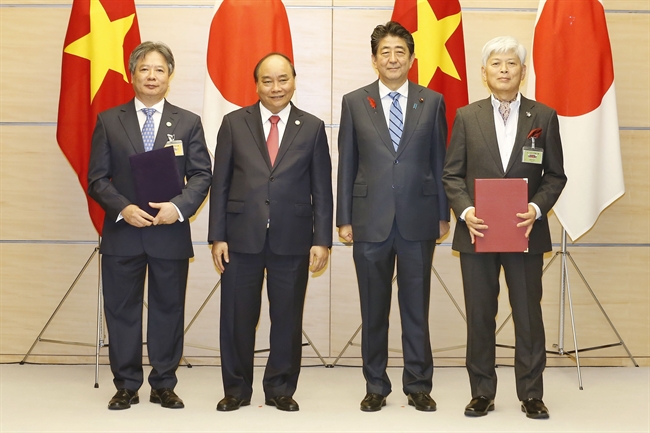 The two leaders witness the exchange of a memorandum of understanding on cooperation between Viet Duc Hospital and Kitahara International Hospital. Photo: Thong Nhat/VNA 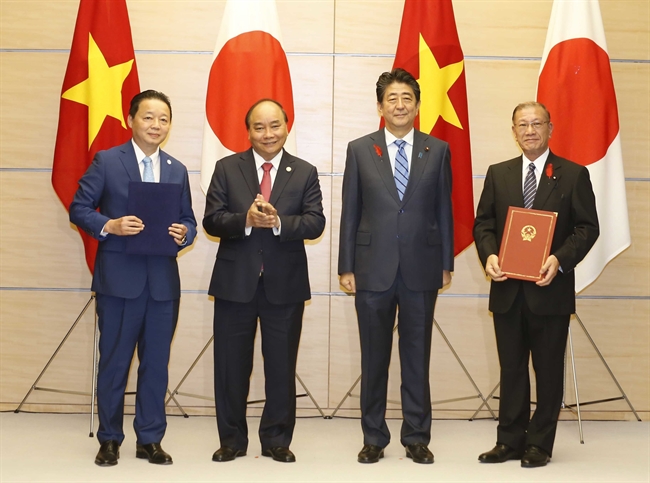 They witness the exchange of the memorandum of understanding on co-operation in maritime policy between the Vietnamese Ministry of Natural Resources and Environment and Japan’s Cabinet Office. Photo: Thong Nhat/VNA 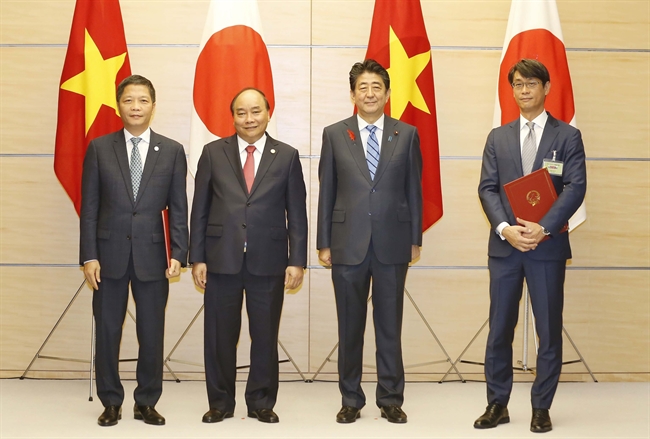 They also witness the signing of a BOT contract between the Ministry of Inudstry and Trade, Sumitomo Group and Van Phong Power Company Limited on Van Phong thermal power plant 1. Photo: Thong Nhat/VNA 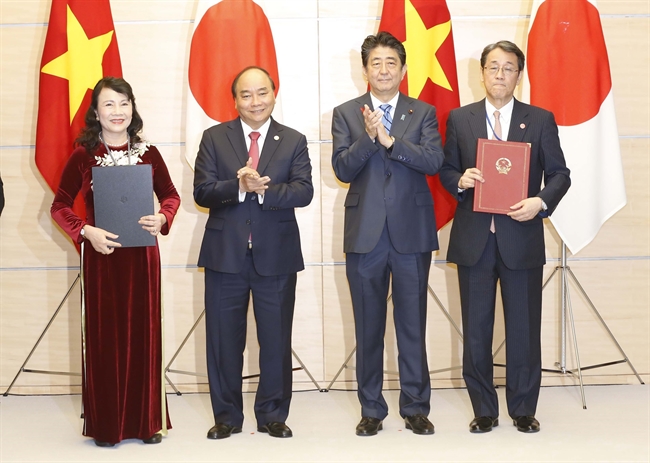 The leaders witness the exchange of an agreement between the Ministry of Education and Training and Japan’s National Police Agency and Ministries of Justice; Foreign Affairs; and Education, Culture, Sports, Science and Technology. Photo: Thong Nhat/VNA 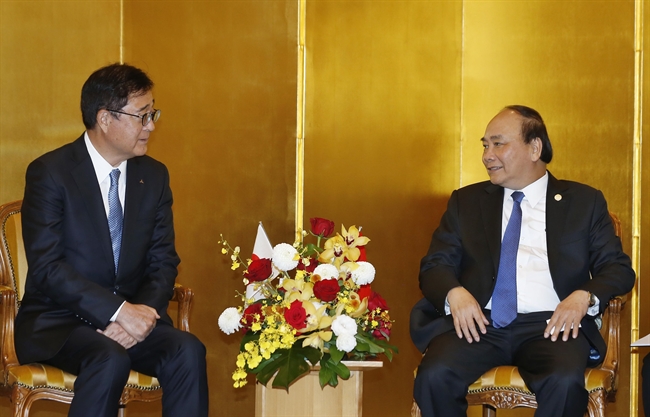 The Vietnamese leader receives CEO of Mitsubishi Motors Osamu Masuko. Photo: Thong Nhat/VNA 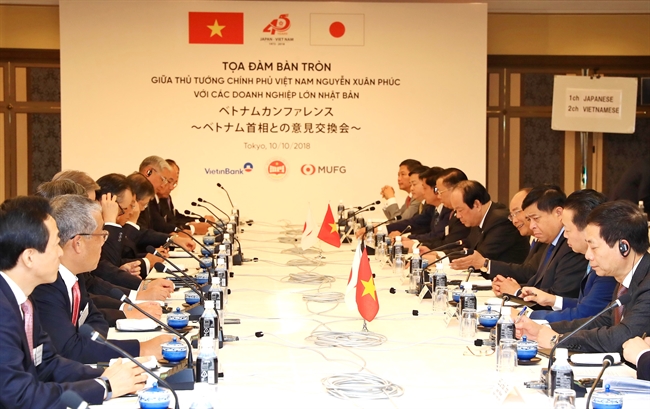 PM Phuc attends a roundtable discussion with Japanese businesses in Tokyo. Photo: Thong Nhat/VNA 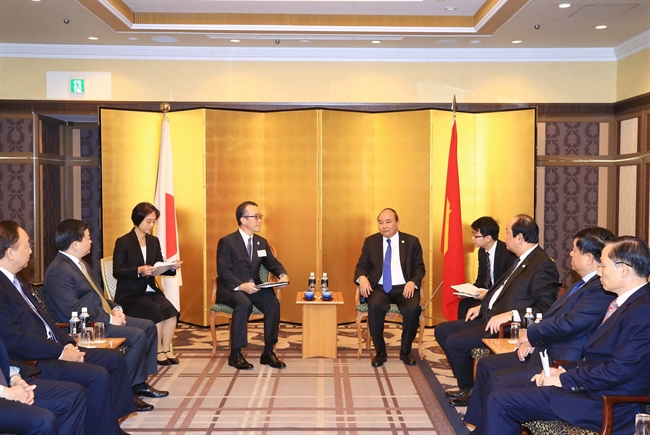 He also has a reception for Chairman at MUFG Union Bank Kanetsugu Mike. Photo: Thong Nhat/VNA 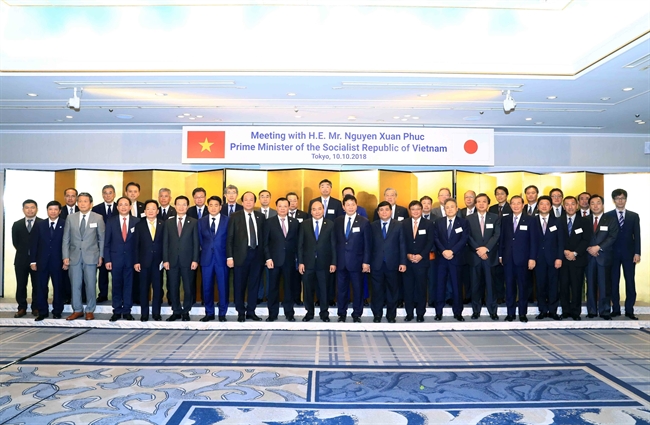 The leader has a meeting with Japanese groups. Photo: Thong Nhat/VNA 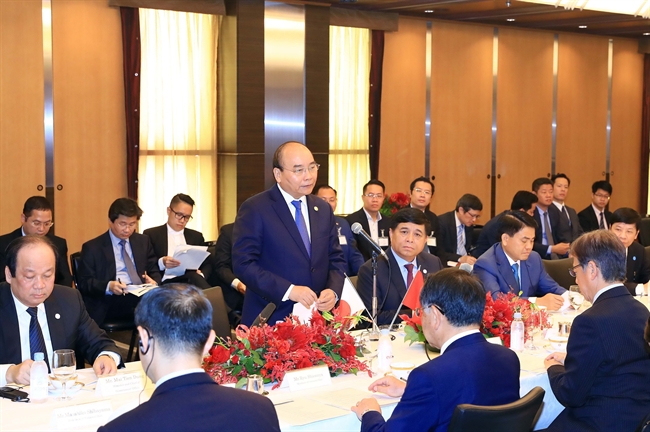 He has a meeting with Japanese real estate enterprises in Tokyo. Photo: Thong Nhat/VNA 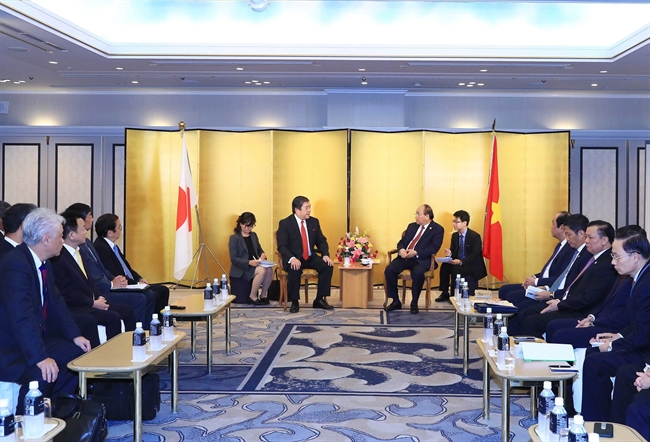 He has a reception for President/CEO of Mitsui & Co. Ltd Tatsuo Yasunaga. Photo: Thong Nhat/VNA 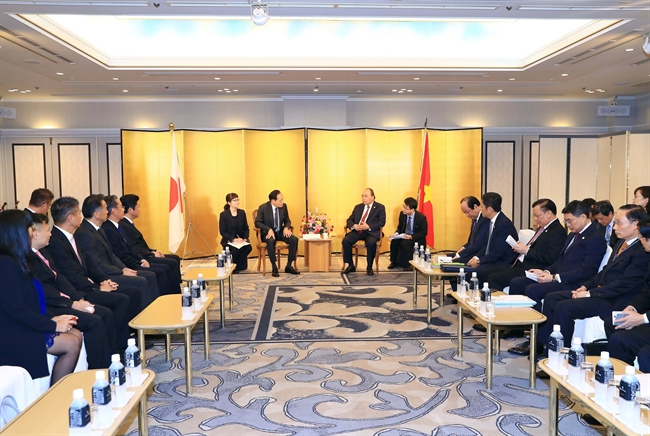 He receives CEO/President of AEON group Motoya Okada in Tokyo. Photo: Thong Nhat/VNA  He also attends the inauguration ceremony of VietjetAir’s flights to Japan. Photo: Thong Nhat/VNA 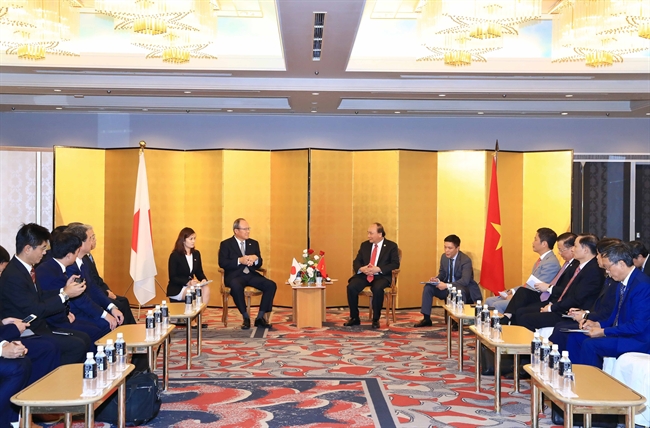 The Vietnamese leader receives President/CEO of Mitsubishi CorporationTakehiko Kakiuchi. Photo: Thong Nhat/VNA |
The number of Japanese enterprises operating in Vietnam is now around 3,100, up 40% over the last four years. The number of Japanese enterprises that are members of the Japan Business Association in Vietnam had by June 2018 reached 1,788, the largest number of all among Japanese business associations in Southeast Asian countries.
Two way trade reached 33.84 billion US dollars in 2017 and 8.7 billion US dollars in the first quarter of 2018. Japan is the fourth largest trader of Vietnam and the largest one among member states of the Comprehensive and Progressive Agreement for Trans-Pacific Partnership (CPTPP).
By VNA/VNP

